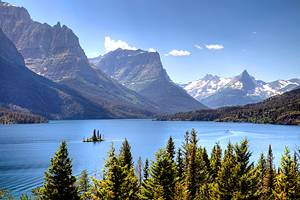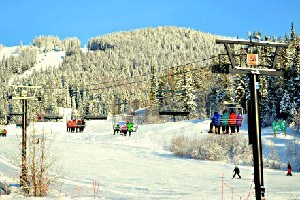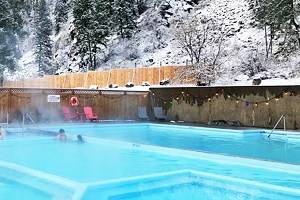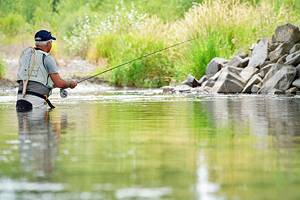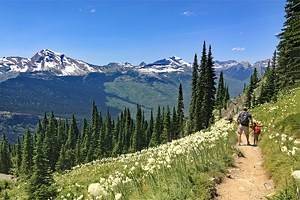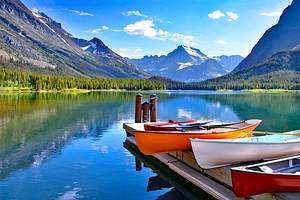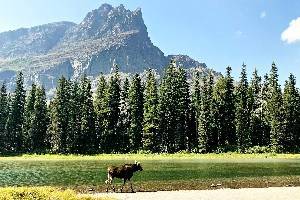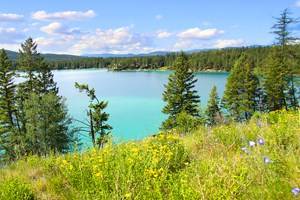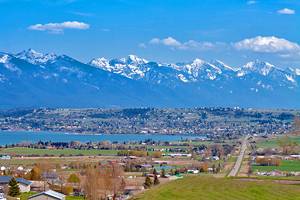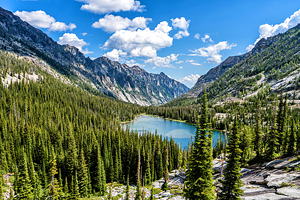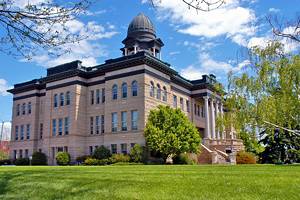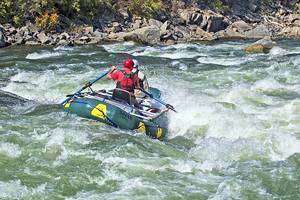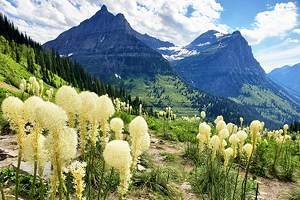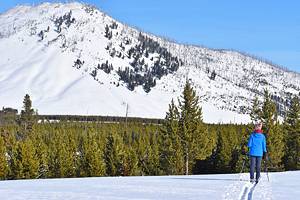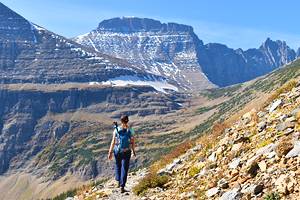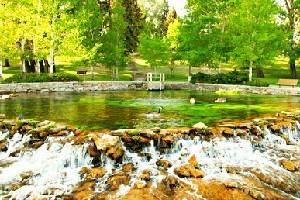Tourist Attractions & Things to Do in Montana
Montana is the American West at its best. This rugged state still has a touch of its wild past brimming from its cities and small towns and its massive unaltered natural spaces. National forest acreage outnumbers residents in Montana, the country's 4th largest state by land size and one of the least populated. These uncrowded spaces have enticed explorers, writers, and Big Sky enthusiasts to Montana over the last 100 years.
Adventure and the outdoors dominate many of the things to do in Montana. And adventures in Montana always come with remarkably beautiful and vast landscapes. From mountains glistening in Glacier National Park to the many wild rivers teeming with trout, the state is a foreign land to some, its wild places unmatched anywhere else in the country.
But it's more than just the opportunities for adventure that make the state worthy of a visit or long stopover. There's also a wild sense of the Old West that still lingers. The state capital, Helena, exemplifies this Western aura with its gold-digging past woven throughout its downtown district. This frontier history of Montana evokes a sense of exploration that feels like something new is around every corner.
Find out why the state is known as the Last Best Place with our list of the top attractions and things to do in Montana.
- Glacier National Park
- Explore a National Forest
- Hit the Slopes at Big Sky Resort
- Fly Fish Blue Ribbon Waterways
- Meet the Residents at the Grizzly and Wolf Discovery Center
- Unearth History at the Museum of the Rockies
- Visit Yellowstone National Park
- Discover the Richest Hill on Earth at the World Museum of Mining
- Tour the State Capitol in Helena
- Explore the Shore of Flathead Lake
- Go Underground at Lewis and Clark Caverns State Park
- Soak in One of Montana's Hot Springs
- Get Inspired at the C.M. Russell Museum Complex
- Spot the Smelter Stack in Anaconda
- Drive the Beartooth Highway
- Visit the Moss Mansion in Billings
- Indulge at the Sweet Palace in Philipsburg
- Ross Creek Cedars Scenic Area
- Pay Respects at the Little Bighorn Battlefield National Monument
- Dive Deep into the Western Heritage Center
- Bike on the Route of the Hiawatha
Glacier National Park
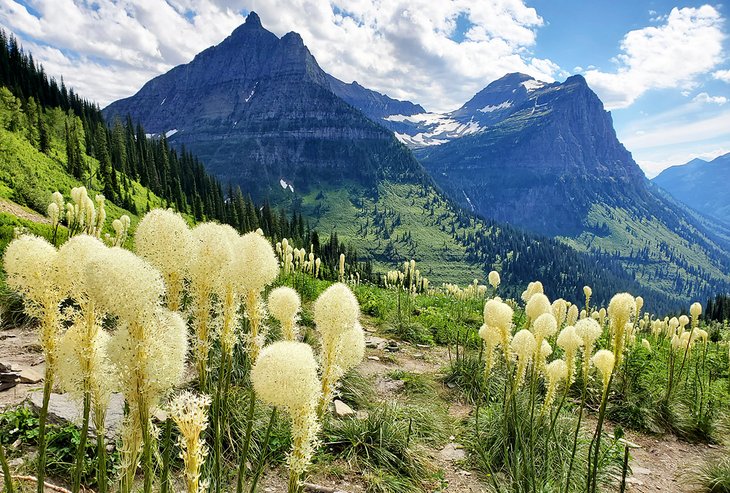
Glacier National Park stands proudly as the Crown of the Continent in Northwest Montana. This outstanding scenic area comprises mountain ranges, alpine meadows, thick forests, tall waterfalls, countless sparkling lakes, and numerous glaciers. It's a real adventure paradise with iconic landscapes enticing repeat visitors for years to come.
The 50-mile-long Going-to-the-Sun Road is a marvel of engineering and the only paved route that navigates across the park. It crosses the Continental Divide at the 6,646-foot-high Logan Pass, connecting St. Mary to Apgar Village and West Glacier. This automobile route is worth a visit alone.
The national park is a magnet for adventure tourists, with over 700 miles of hiking trails. Some of the most iconic hiking routes include Grinnell Glacier, Ptarmigan Tunnel, and the incredible Highline Trail. While day hiking is the most common way to explore, overnight adventures are also popular within the park's extensive backcountry.
Read More:
Explore a National Forest
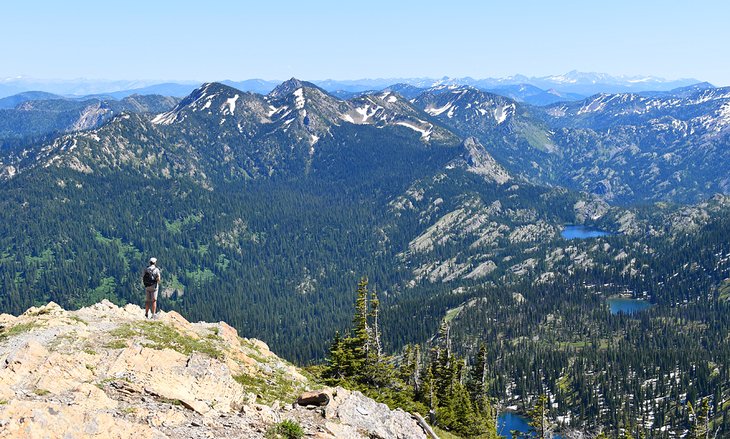
Montana is home to a remarkable seven national forests comprising nearly 20 million acres. This vast, wide-open space has come to define the Montana experience, and no visit is complete without trekking through these public lands. From the Kootenai to the Custer-Gallatin, the western half of the state is home to many of these national treasures.
At least five national forests are within a short drive of Missoula, home to the University of Montana. And Lolo National Forest surrounds the city. This proximity to public lands offers residents and visitors backyard access to adventure hot spots like Rattlesnake and Blue Mountain National Recreation Areas.
Bozeman, home to Montana's other state university, is also an excellent jumping-off point for exploring national forests. While several public lands are within reach, the Custer-Gallatin National Forest draws the most interest. South of Bozeman, the Custer-Gallatin reaches past the adventurous town of Big Sky and connects to Yellowstone National Park.
Read More: Hiking Trails in Montana
Hit the Slopes at Big Sky Resort
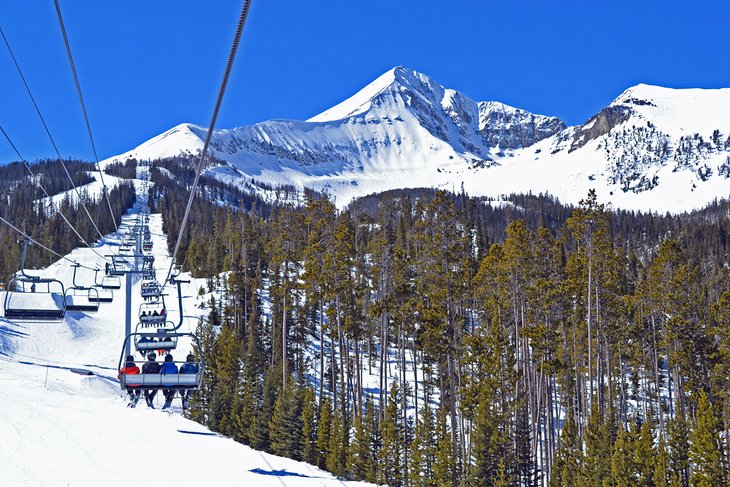
Big Sky Resort, home to some of the "Biggest Skiing in America," is approximately an hour's drive south of Bozeman. The slopes are known for their abundance of snow, with an average of 400 inches per year. Thousands of skiers and snowboarders descend onto the resort come winter. Still, with 5,750 skiable acres, there's plenty of room to make some turns.
Visiting Big Sky provides the full resort experience. From the heated eight-person lifts to the energetic base of the mountain filled with events, restaurants, and après-ski entertainment, Big Sky offers the crème da la crème of a Montana downhill experience. The resort recently upgraded their iconic Lone Peak Tram for the 2023/24 season, offering a breathtaking and sightseeing adventure to the top of its namesake peak and an adventurous black-diamond ride down for those comfortable with steep terrain. Down rides are also available.
But Big Sky isn't the only ski destination worth visiting in the state – several of Montana's best ski resorts offer similar landscapes for downhill endeavors. Lost Trail Powder Mountain is a local favorite near the Idaho border. And up north, Whitefish Mountain Resort offers excellent views of the adjacent Glacier National Park. Other popular spots like Montana Snowbowl and Bridger Bowl are within easy reach of Montana's university cities.
Address: 50 Big Sky Resort Road, Big Sky, Montana
Official site: https://bigskyresort.com/
Read More: Things to Do in Big Sky, Montana
Fly Fish Blue Ribbon Waterways
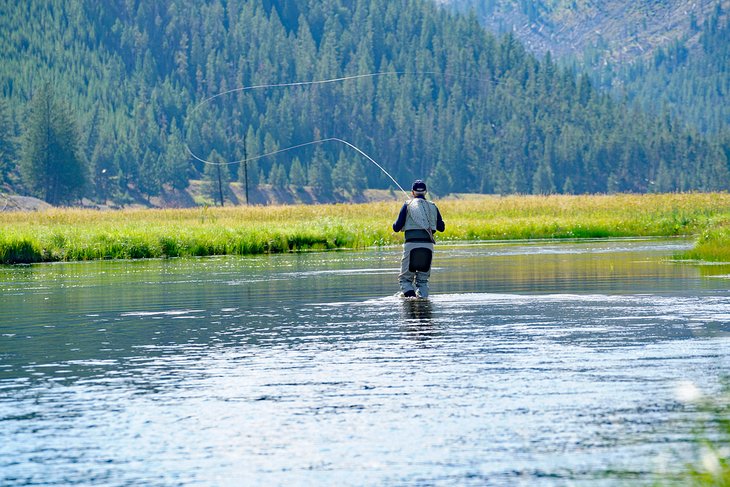
The 1992 movie, A River Runs Through It, starring Brad Pitt and directed by Robert Redford, made Montana synonymous with fly fishing. But anglers have been casting lines in the state for years prior, already aware of the surplus of mountain streams and rivers primed for a fly.
The movie, adapted from an iconic 1972 novella by Norman Maclean, takes place primarily on the Blackfoot River. But many of the most mesmerizing river scenes were filmed on the Gallatin River. These two rivers both offer productive seasonal hatches and some of the best mountain scenery in the sport.
And world-renowned fly fishing takes place throughout the state. Besides other major rivers like the Madison, Missouri, and Yellowstone Rivers, the state has thousands of mountain streams and creeks with plenty of action. One of the best ways to enjoy Montana fly fishing is by connecting with a local guide shop.
Meet the Residents at the Grizzly and Wolf Discovery Center
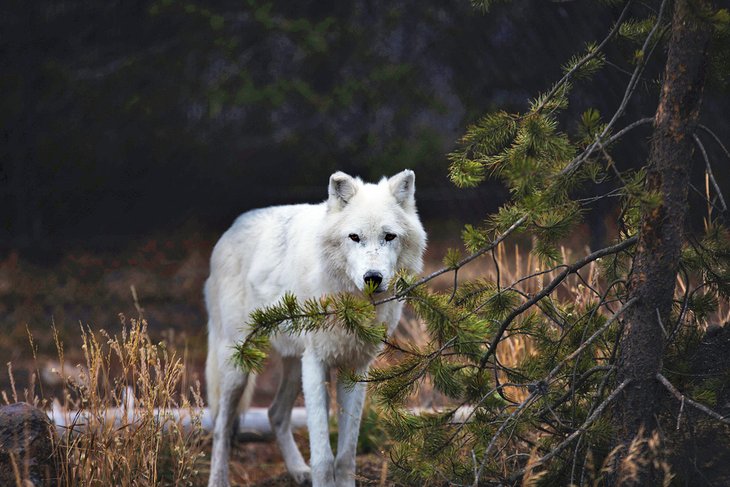
Undoubtedly the only time you'll be happy to see a bear or wolf up close, the Grizzly and Wolf Discovery Center is a must-see excursion when visiting Montana. It's in the town of West Yellowstone, near the western entrance of Yellowstone National Park.
Opened as a sanctuary for animals otherwise not fit to live in the wild, the center offers a chance to see giant grizzly bears and gray wolves in a natural habitat. It also encourages learning about their behavior, history, and population decline. Highlights include watching the bears forage for food, play in their ponds and with each other, as well as the chance to hear the haunting howls of the wolf packs (best in the mornings and evenings).
The facility also features an engaging Banks of the Yellowstone indoor exhibit, with a dynamic riparian display with cutthroat trout and river otters.
Address: 201 S. Canyon Street, West Yellowstone, Montana
Official site: www.grizzlydiscoveryctr.org
Read More: Things to Do in West Yellowstone, MT
Unearth History at the Museum of the Rockies
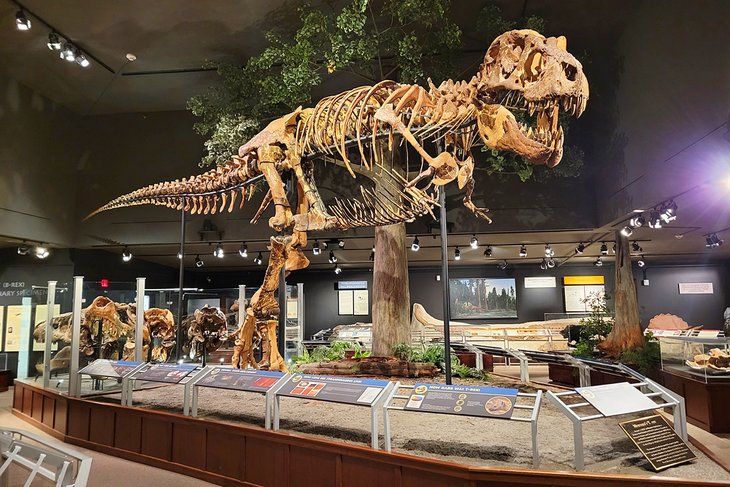
The Museum of the Rockies adds to Bozeman's status as one of Montana's best cities. Along with its planetarium, the museum – part of the Smithsonian Institution – is renowned for its excellent displays of dinosaurs and dinosaur eggs. The collection includes skeletons and realistic models of numerous species found in the state.
The museum's dinosaur collection is one of the largest in the US and includes the world's biggest Tyrannosaurus skull. Other highlights include a T-Rex thighbone with soft-tissue remains and the T-Rex skeleton at the museum entrance known as "Big Mike." All these prehistoric monuments help share the region's history.
It's not all dinosaurs, however. The museum also features a dynamic display welcoming people to Yellowstone Country, illustrating the region's evolution into a tourism magnet. Other subject matters include native peoples of the region, Western art exhibits, and the Tinsley House – an original pioneer log home from the late 1800s.
Address: 600 W. Kagy Blvd, Bozeman, Montana
Official site: https://www.museumoftherockies.org/
Read More: Attractions and Things to Do in Bozeman, MT
Visit Yellowstone National Park

Montana has two main entrances into Yellowstone National Park, the nation's first national park. These two openings, the West Entrance and the North Entrance, also feature gateway communities that are fun places to visit on their own. And it's a world of adventure once you're inside the park, with over two million acres to explore.
From the aptly named town of West Yellowstone, the West Entrance of Yellowstone dives deep into geyser country. After reaching the iconic Madison Junction 14 miles from the entrance, the road diverges, with top Yellowstone attractions either way. North of the Madison Junction is Norris Geyser Basin, home to Steamboat Geyser. The Lower, Midway, and Upper Geyser Basins are to the south, with big-name sights like Grand Prismatic and Old Faithful.
The North Entrance of Yellowstone is in Gardiner, Montana. This entrance is accessible via a beautiful 90-minute drive through Paradise Valley from Bozeman. Shortly after the park's gates, the Boiling River, another top attraction of Yellowstone, invites immediate exploration. Farther into the park, the Mammoth Hot Springs area offers stunning travertine terraces and a touch of the park's history.
Read More: Hiking Trails in Yellowstone National Park
Discover the Richest Hill on Earth at the World Museum of Mining
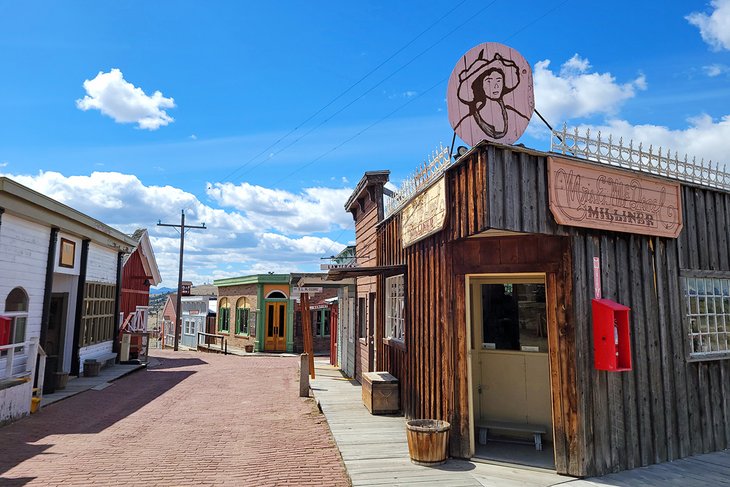
Butte, once known as the Richest Hill on Earth, is Montana's most historic city. It began in the late 1800s and flourished in the copper mining industry. It grew to be Montana's first major city and the biggest city between Chicago and San Francisco for a period in history.
Mining operations continued into the 1980s in Butte, though never reaching their early 1900s heydays ever again. Today, this history and culture are still on full display, making Butte one of Montana's best places to visit. One of the best places to dig into the city's mining history is the World Museum of Mining.
The museum centers around a restored mining camp with more than three dozen historic buildings and structures on display. It was part of the old community known as Hell Roarin' Gulch at the base of a now inactive silver and zinc mine. A highlight is the huge headframe – the winding tower at the mineshaft's head – along with underground tours of the mines.
Other mine-related highlights in Butte include the Copper King Mansion, constructed in 1888. This 24-room Victorian mansion features many of the original artifacts that reflect the prosperity of the Richest Hill on Earth. The Mineral Museum is also a fun place to visit, featuring more than 1,300 specimens, like a 27-and-a-half-troy-ounce gold nugget.
Address: 155 Museum Way, Butte, Montana
Official site: https://miningmuseum.org/
Read More: Things to Do in Butte, Montana
Tour the State Capitol in Helena

Montana's capital, Helena, once known as Last Chance Gulch after a group of disheartened gold-diggers decided to have one final dig before striking gold, possesses one of the most attractive state capitol buildings in the US.
The building reflects a Greek Renaissance-style of architecture with sandstone and granite composing much of the facade. It's topped with a copper dome and houses several eye-catching murals featuring themes of Montana's past. The iconic Montana artist, Charles M. Russell, has a mural in the building depicting Lewis and Clark meeting the Salish Indians.
It's not just the state capitol that makes Helena a pleasure to visit. The city has a distinct and vibrant culture tied to its gold-digging days of the past. Historical places like Reeder's Alley co-mingle with the modern art galleries and hip storefronts nearby.
Helena is also a great base camp for exploring the Montana countryside. The two-million-acre Helena-Lewis and Clark National Forest surrounds the entire city. Popular things to do in the forest include fishing, hiking, backpacking, and big game viewing. For an even closer adventure, the expansive Mount Helena City Park is within walking distance of downtown.
Read More: Attractions & Things to Do in Helena, MT
Explore the Shore of Flathead Lake
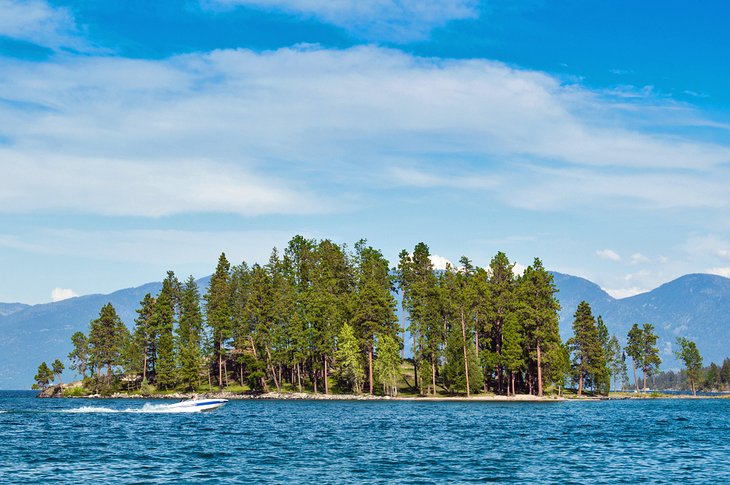
Flathead Lake is the largest natural freshwater lake in the American West outside of Alaska. It's in the northwest part of the state, approximately 25 miles south of Whitefish. The lake has over 160 miles of shoreline, meaning it takes a while to drive its length.
Boating and boating activities tend to reign supreme at Flathead Lake. The lake is known for its crystal-clear water alongside its icy depths. And adventure extends from the shoreline, too, with hiking trails and parks operated by either Montana Fish, Wildlife & Parks, or the Confederated Salish and Kootenai Tribes.
Like Polson and Bigfork, small towns punctuate the shoreline with services like restaurants and boat rentals. Less than 15 miles north, Kalispell is another Montana city worth checking out, and a great spot to find a hotel to spend the night near Flathead Lake.
Read More: Things to Do near Flathead Lake, Montana
Go Underground at Lewis and Clark Caverns State Park

Lewis and Clark Caverns is between Butte and Bozeman. It's Montana's first state park and a popular spot to explore underground. And the only way to experience its depths is as part of a guided tour led by park staff. Three different tours are available during the summer that cater to different ability levels. And a special Winter Holiday Candlelight Tour occurs throughout the colder months.
Lewis and Clark Caverns are one of the largest limestone caverns in the world. They host colossal cave features, handrails, and resident bats. Tours follow a concrete walkway the entire way and never navigate through tight spaces. For those not affected by claustrophobia, the state park does offer a unique three-hour Wild Cave Tour that does include some crawling.
Outside the cavern, the park's aboveground area has hiking trails and a visitor center with interpretive information about the caves. The cavern's campground is also above ground, with cabins, tipis, and group campsites available. Reservations are recommended for campsites and cave tours.
Address: 25 Lewis & Clark Caverns Road, Whitehall, Montana
Official site: https://fwp.mt.gov/stateparks/lewis-and-clark-caverns/
Soak in One of Montana's Hot Springs
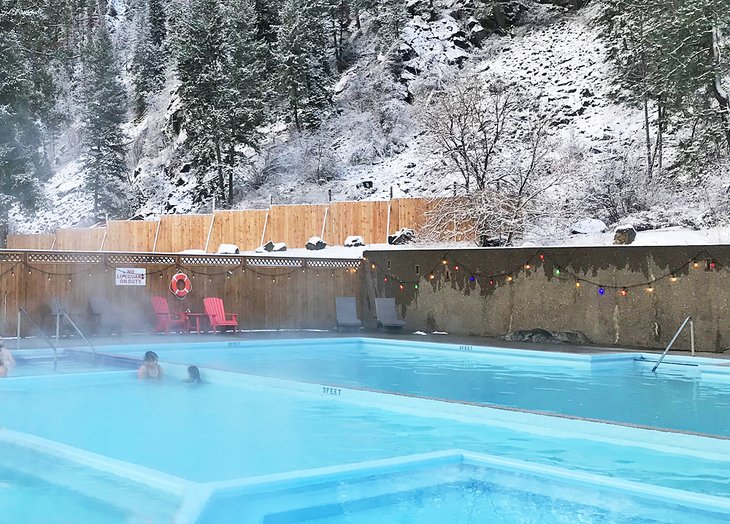
Among its many natural features, Montana has several hot spring facilities that inspire a soak. Many of Montana's mainstream hot springs are developed, meaning it's usually a pool of some sort with natural hot water piped in. These hot springs vary in size and are mostly found in the state's western half.
One of the best hot springs in Montana is Quinn's Hot Springs Resort, located next to the Clark Fork River in Paradise, Montana, an hour's drive northwest of Missoula. This beautiful hot spring resort recently added more natural outdoor pools to its landscaped grounds. The resort also offers lodge rooms, cabins, and the decadent Hardwood House Restaurant.
The most historic hot spring, Chico Hot Springs, is another fun one to visit. Alongside a large open-air pool, it's the ambiance of this historic resort, established in 1900, that makes for a memorable visit. That and its prime location within Paradise Valley, close to the Yellowstone River and a short scenic drive to Yellowstone National Park.
Other notable soaking spots include Lolo Hot Springs near the Idaho border and Elkhorn Hot Springs in the Pioneer Mountains. And Yellowstone Hot Springs, 30 miles south of Chico Hot Springs, is a relatively new hot spring with one of the state's best outdoor pools.
Get Inspired at the C.M. Russell Museum Complex
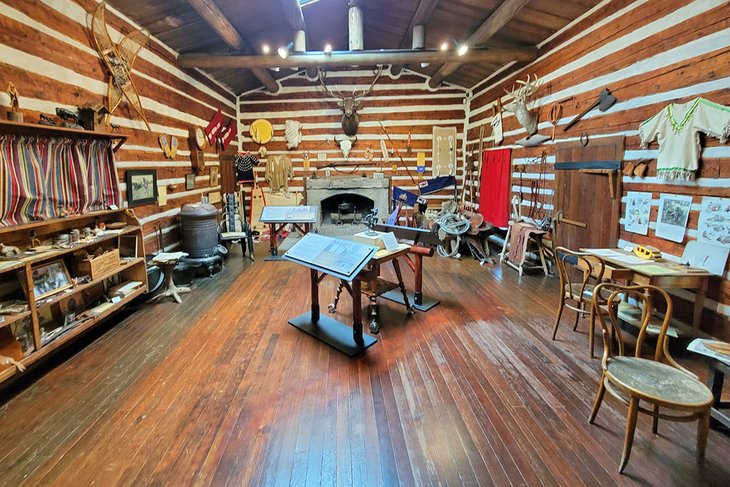
In Great Falls, the C.M. Russell Museum celebrates the life and work of famed US artist Charles M. Russell, perhaps best known as the Cowboy Artist. The museum includes numerous documents and artifacts relating to the artist's career spanning the end of the 19th and early 20th centuries and an extensive collection of original paintings.
A highlight is visiting the original Russell House and Studio, now designated a National Historic Landmark. Also of interest is the museum's Russell Riders Sculpture Garden with its statues of area wildlife. The museum also has entire wings dedicated to Russel's many contemporaries, offering a vast and varied collection of Western artworks.
The city of Great Falls itself offers several other things to do to tack onto a long weekend. The Lewis and Clark Interpretive Center is a great place to learn about a different slice of regional history. Natural spaces also line the city, like Giant Spring State Park and Gibson Park, many of which connect to the River's Edge Trail.
Address: 400 13th Street N., Great Falls, Montana
Spot the Smelter Stack in Anaconda
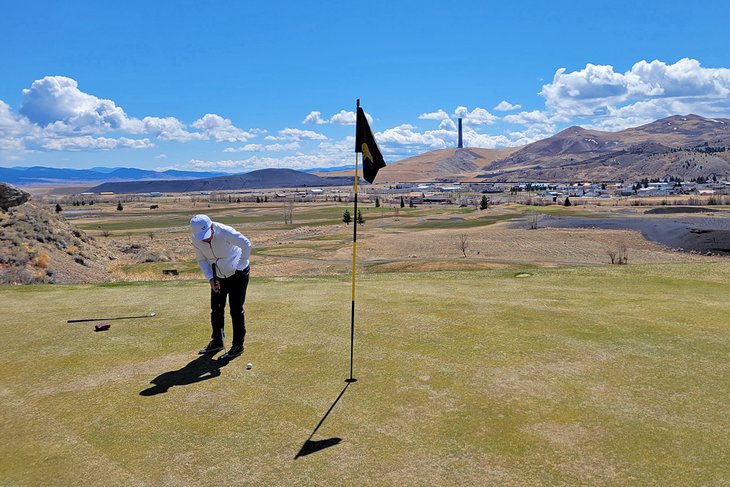
Anaconda is a historic town in Western Montana, dating back to the copper mining days of the late 1800s. This history is on display throughout the town, including a preserved smelter stack towering on the horizon. Today, it's a vacation destination for its modern but rustic attractions and its easy access to the great outdoors.
A few fun things to do in Anaconda include hot spring adventures and skiing at the nearby Discovery Ski Area. Anaconda is also home to the Jack Nicklaus Old Works Golf Course. This unique 18 holes sits upon an old refinement site and features black "slag" bunkers – a byproduct from the smelting days.
Anaconda sits near the end of the Pintler Veteran's Memorial Scenic Highway. This 64-mile route offers a beautiful alternative for I-90 and a recommended course for adventure when traveling from Yellowstone to Glacier. The Scenic Highway is also a launching point for adventures into the surrounding Beaverhead-Deerlodge National Forest.
Drive the Beartooth Highway
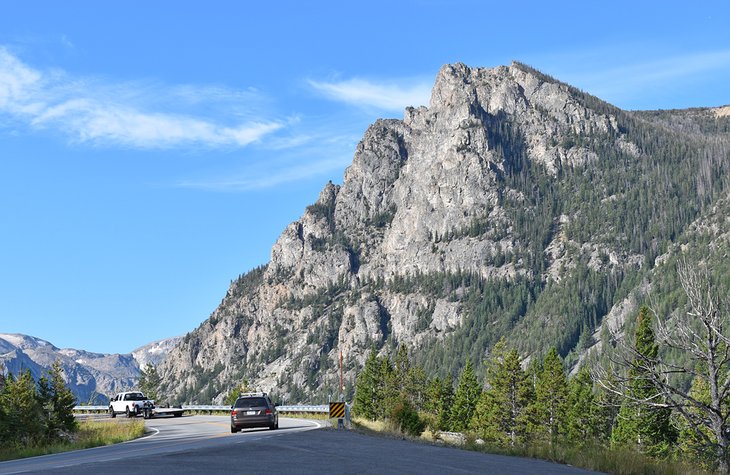
The Beartooth Highway is in southwest Montana and leads into Wyoming. It is an All-American Road and a true marvel of engineering. Comparable to the Going-to-the-Sun Road in Glacier National Park, but less crowded, this 68-mile route switchbacks up and over a mountain pass for fantastic views.
The route begins south of Red Lodge, one of Montana's best small towns. The road then climbs over 5,000 feet to reach Beartooth Pass (elevation 10,947 feet) on the other side of the Wyoming border. The highway then proceeds west throughout Shoshone National Forest to the northeast entrance of Yellowstone National Park.
It's truly a bucket-list drive, even though it's not as well-known as some other Montana adventures. The highway is typically open between Memorial Day and Columbus Day (May through October), weather dependent. And with hiking trails, campgrounds, and stunning landscapes lining the way, plan for ample time driving the 68-mile route.
Read More: Things to Do in Red Lodge, Montana
Visit the Moss Mansion in Billings
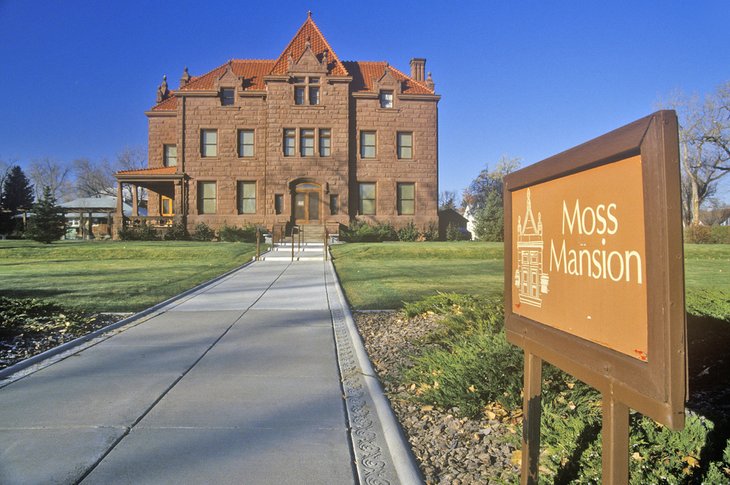
The Moss Mansion Historic House Museum is one of the most important landmarks in Billings, comprising a large red sandstone manor that dominates its neighborhood. Renowned New York architect Henry Janeway Hardenbergh designed the 28-room mansion in 1903. His previous works included the Waldorf Astoria, Plaza, Willard, and Copley Plaza hotels.
The mansion features original draperies, fixtures, furniture, Persian carpets, and artifacts. It's like stepping back in time when going inside. Guided and self-guided tours are available. The site also hosts temporary displays and exhibits, including seasonal events and festivals.
Billings is Montana's most populated city with over 100,000 residents. Alongside the fascinating history at the Moss Mansion, the city has several notable tourist attractions and things to do. It's also surrounded by a fantastic landscape, well represented by the massive Rimrocks jutting throughout the center of town. Billings is also home to ZooMontana, the Yellowstone Art Museum, and Pictograph Cave State Park.
Address: 914 Division Street, Billings, Montana
Official site: www.mossmansion.com
Indulge at the Sweet Palace in Philipsburg

In Phillipsburg, on the Pintler Veteran's Memorial Scenic Highway, the Sweet Palace is a candy lover's dream come true. Rows and rows of candy jars line this old-fashioned candy shop, offering all types of flavors and confectionary styles. Visitors add to their bags as they are shopping, with most candies costing the same per pound.
The Sweet Palace is only one of many things to do in Philipsburg. The main drag, where the Sweet Palace is centrally located, has several other local shops and attractions worth a full afternoon of perusing. This includes places to shop for and sluice out the city's most precious resource: Montana sapphires.
Ross Creek Cedars Scenic Area
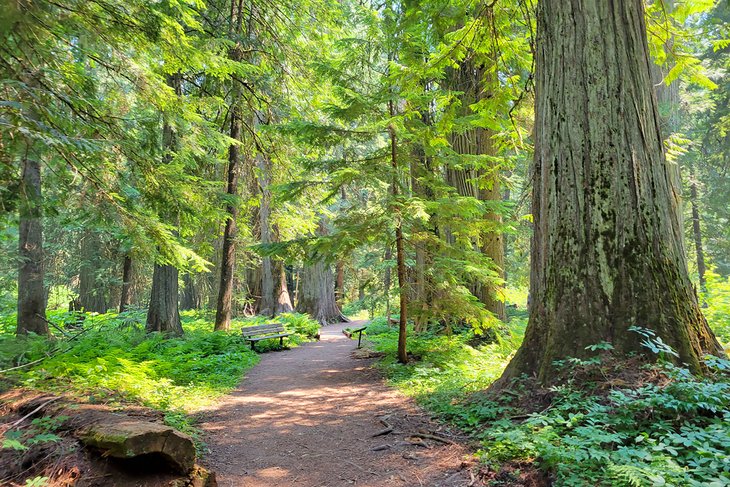
Ross Creek Cedars Scenic Area is a notable point of interest in Kootenai National Forest. This ancient grove is in the far northwest part of the state, near the border with the Idaho Panhandle. And within its approximately 100 acres, a tall world awaits.
Some of the cedars in this scenic area have been growing for over 1,000 years. Today, visitors crane their necks at these long-living hardwoods along a 0.9-mile interpretive path. Take some time on this wide and accessible path, listening to the sounds of Ross Creek rumbling nearby.
Expect some crowds on the weekends and throughout summer at Ross Creek. It's a bit of a drive on a dirt road to access the scenic area. Downloaded GPS coordinates are helpful when visiting for the first time. Visitors can also extend the hike for up to four miles along the Ross Creek Trail, where it's easy to ditch the crowds and connect with nature.
Pay Respects at the Little Bighorn Battlefield National Monument
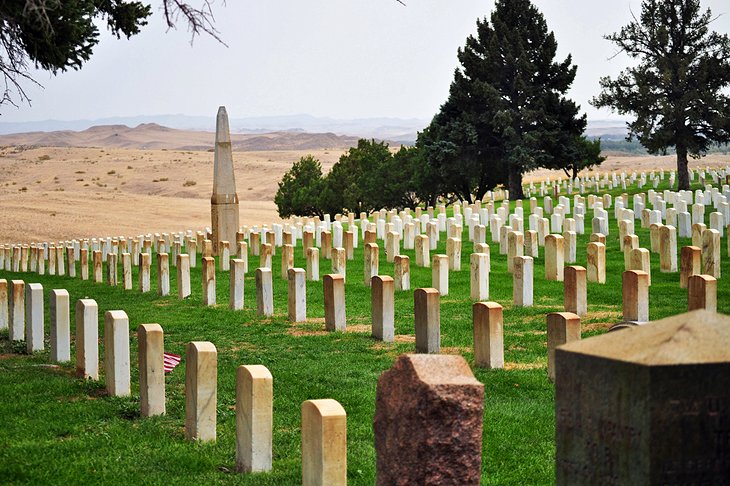
The Little Bighorn Battlefield National Monument commemorates the 1876 clash between the US Army and Sioux and Cheyenne Indians. It is one of the best-known historical landmarks in the US – and one of the most important in terms of the reconciliation that has taken place since. This must-see attraction includes a visitor center, museum, the Custer National Cemetery, the 7th Cavalry Memorial, and the Reno-Benteen Battlefield.
For the most in-depth experience at the battlefield, book an Apsaalooke Tour, available throughout the summer between Memorial Day and Labor Day. The Crow Nation of Tourism offers this one-hour, air-conditioned bus tour across the battlefield, providing perspectives on this significant historic landmark.
Address: Interstate 90 Frontage Road, Crow Agency, Montana
Official site: https://www.nps.gov/libi/index.htm
Dive Deep into the Western Heritage Center
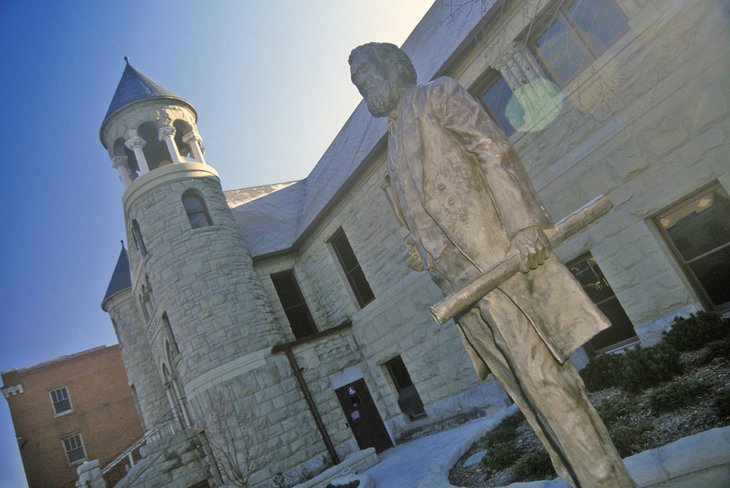
Another Billings attraction worth a visit is the Western Heritage Center, housed in the old Parmly Billings Memorial Library built in 1901. The center features a diverse collection of more than 17,000 artifacts. Highlights include more than 6,000 photos covering the history and culture of the Yellowstone River region.
Opened in 1971 and now affiliated with the Smithsonian Institution, the museum also houses a broad collection of materials focusing on the history of the Northern High Plains and Yellowstone River Valley. It also has a special focus on the preservation of the histories of the Cheyenne and Crow Indians. Other highlights include lectures, educational programs, and workshops.
Address: 2822 Montana Ave, Billings, Montana
Official site: www.ywhc.org
Bike on the Route of the Hiawatha
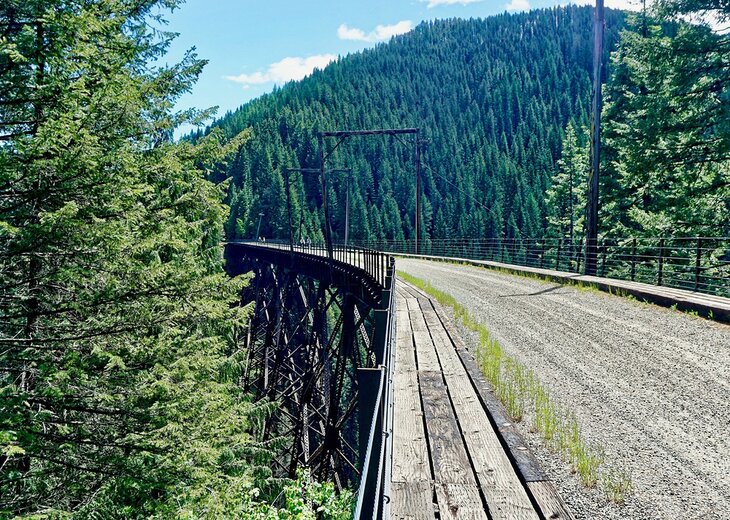
The Route of the Hiawatha is one of the most scenic rail-to-trail conversions in the country, departing from Lookout Pass at the Idaho/Montana border. It spans approximately 15 miles and primarily follows a downhill grade, meaning riders can coast most of the route. Along the way are 10 scenic tunnels and seven trestle bridges that span high above the mountainous environment.
Lookout Pass operates the shuttles and bike rentals that make this scenic bike ride a breeze. The route and rentals are only available throughout the summer season, approximately between Memorial Day and Labor Day. Trail passes are required to ride, and most finish the bike ride within approximately two hours.


